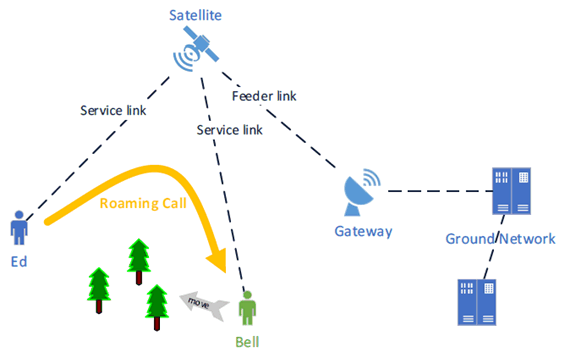Content for TR 22.865 Word version: 19.2.0
5.7 Use case on the support of UE-satellite-UE phone call
5.7.1 Description
5.7.2 Pre-conditions
5.7.3 Service Flows
5.7.4 Post-conditions
5.7.5 Existing features partly or fully covering the use case functionality
5.7.6 Potential New Requirements needed to support the use case
...
...
5.7 Use case on the support of UE-satellite-UE phone call p. 21
5.7.1 Description p. 21
Known as the "Lung of the Earth", the Amazon Rainforest locates in the the Amazon Basin of South America, with a total area of 700 million hectares, spanning eight countries, and is the largest and most diverse tropical rainforest in the world. Although the Amazon rainforest is known as a paradise for animals and plants, it is a terrible "forbidden area" for human beings. Lives will be exposed to various dangers if we enter the Amazon rainforest without any preparation.
Vipers, crocodiles, bacteria and viruses, or even swamp can destroy the vulnerable human life. However, many explorers and tourists still step into this land every year. When they get into troubles, the most important thing is that they can communicate with the nearest first-aid station or other teams timely. However, in the deep of the dense primordial forest, there are no modern communication infrastructures and even no power supplies.
The satellite will help conquer such a desperate plight because it can provide timely access for the terminals without any surrounding terrestrial infrastructures. In this way, the injured can find the nearest first-aid station and make a quick phone call. Based on the potential positioning capability of the satellite, the rescue team can also find the position of the injured efficiently.
However, due to the explorers and tourists are always from different countries, they may not belong to only one mobile operator. So they need mechanisms, such as roaming, between different mobile operators' network even all of them access the same one satellite.
Moreover, some studies show that the ground segment need to be detailed designed and implemented, and there will be a serious dilution of the communication efficiency based on existing mechanisms in both satellite network and mobile network, especially data transferring and switching. So, it will benefit that enhance the capabilities of data processing and switching within the satellites.

Figure 5.7.1-1: Phone call through one satellite without going through ground network
(⇒ copy of original 3GPP image)
(⇒ copy of original 3GPP image)
5.7.2 Pre-conditions p. 22
Ed is an explorer from Country A, and his phone has a subscription with the terrestrial operator TerrA.
Bell is a rescuer working in the Amazon Rainforest, and his phone has a subscription with the terrestrial operator TerrB.
TerrA has roaming agreement with TerrB and TerrB has agreements with the satellite operator SatA for satellite access.
SatA maintains multiple serving satellites for the 5G subscribers all over the world, Amazon Rainforest is one of SatA's serving areas.
Ed signed up a roaming plan from TerrA for accessing TerrB's mobile network in case of keeping in touch with others in the Amazon Rainforest.
5.7.3 Service Flows p. 22
- Ed is hiking along the planned route in the Amazon Rainforest, with good connection to ground network through satellite access.
- Suddenly, Ed is knocked by a piece of deadwood and his left arm is wounded.
- Ed can not go on his ride with poor medical measures, so he dials the rescue phone number for help.
- Based on the position information of Ed provided by SatA and TerrB, the rescue center finds Bell is the nearest rescuer and transfers the call to Bell.
- Bell answers the phone call with satellite access and tries to find Ed based on the real-time position information of Ed. For lower communication latency, this phone call is routed by only one satellite without going through the ground network of TerrA and TerrB.
5.7.4 Post-conditions p. 22
Bell runs towards to Ed as soon as possible and keeps talking to him, finally Ed is saved.
5.7.5 Existing features partly or fully covering the use case functionality p. 22
3GPP TS 22.261,
clause 6.1.2.1 on network slice includes the following requirements:
The serving 5G network shall support providing connectivity to home and roaming users in the same network slice.
The 5G system shall be able to support IMS as part of a network slice.
clause 6.2.4 includes roaming related requirements in diverse mobility management:
For a 5G system with satellite access, the following requirements apply:
clause 6.3.2.3 on satellite access includes the following requirement:
- A 5G system with satellite access shall enable roaming of UE supporting both satellite access and terrestrial access between 5G satellite networks and 5G terrestrial networks.
- UEs supporting satellite access shall support optimized network selection and reselection to PLMNs with satellite access, based on home operator policy.
The 5G system shall be able to provide services using satellite access.
clause 9.1 on charging aspect includes the following requirement:
The 5G core network shall support collection of charging information based on the access type (e.g. 3GPP, non-3GPP, satellite access).
5.7.6 Potential New Requirements needed to support the use case p. 23
[PR 5.7.6-001]
Subject to regulatory requirements and operator's policy, the 5G system with satellite access shall support providing connectivity between UEs without going through the ground network regardless if they are registered in the HPLMN or a VPLMN.
[PR 5.7.6-002]
The 5G system with satellite access shall support collection of charging information for a UE registered to the HPLMN or a VPLMN, without going through the ground network.